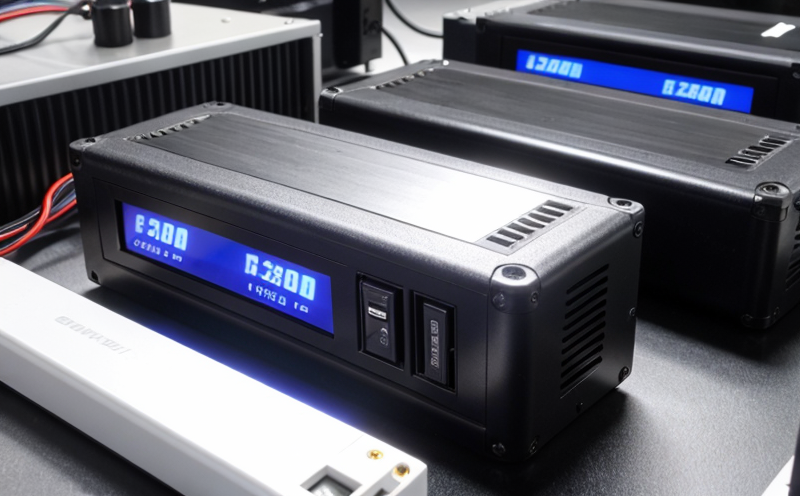UNE EN 50342 Performance Testing of Automotive Lead-Acid Batteries
The UNE EN 50342 standard is specifically tailored to ensure that automotive lead-acid batteries meet the high performance and reliability expectations set by industry regulations. This comprehensive testing protocol covers a wide range of performance parameters, ensuring that each battery can deliver consistent power under various operating conditions.
UNE EN 50342 is designed to address critical aspects such as electrical resistance, capacity retention, cycle life, and cold cranking current. These tests are essential for validating the durability and safety of automotive lead-acid batteries used in vehicles worldwide. The standard also emphasizes environmental considerations, ensuring that the batteries comply with stringent emission standards.
Compliance with UNE EN 50342 is crucial for manufacturers who aim to meet global market demands. Many automakers and regulatory bodies have adopted this standard as a benchmark for quality assurance in automotive components. By adhering to these rigorous testing protocols, battery manufacturers can enhance their product's reliability and safety, thereby gaining competitive advantage.
The process of UNE EN 50342 testing involves several key steps that ensure thorough evaluation. Specimen preparation is critical; batteries must be conditioned under controlled conditions before undergoing performance tests. This includes charging to a specified state-of-charge and storage at specific temperatures for an appropriate duration.
During the test, various parameters are monitored continuously, including voltage, current, temperature, and specific gravity. The testing apparatus used in this process is highly sophisticated, capable of providing precise measurements across all relevant parameters. Reporting of results follows strict guidelines outlined by the standard, ensuring that data is accurate, reproducible, and compliant with international norms.
UNE EN 50342 performance testing not only enhances product quality but also contributes to environmental sustainability by promoting the use of reliable and efficient automotive lead-acid batteries. The detailed test procedures ensure that each battery meets stringent safety standards, thereby reducing risk in vehicle operation.
Why It Matters
Compliance with UNE EN 50342 is not just a regulatory requirement; it’s essential for maintaining the integrity of automotive systems. Automotive lead-acid batteries play a crucial role in powering vehicles, providing backup power during emergencies, and ensuring reliable engine start-up. Any failure in these critical components can have serious consequences, affecting vehicle performance and safety.
The standard ensures that batteries are robust enough to withstand harsh environmental conditions common in automotive environments. This includes exposure to extreme temperatures, vibrations, and electrical stress. By adhering to UNE EN 50342, manufacturers ensure their products meet these challenges, enhancing the overall reliability of vehicles on the road.
Environmental considerations are also a significant focus of this standard. Lead-acid batteries contain hazardous materials that require proper disposal and recycling. Ensuring compliance with UNE EN 50342 helps promote sustainable practices by encouraging manufacturers to design products that minimize environmental impact. This aligns with global efforts towards reducing waste and promoting circular economy principles.
From a business perspective, adherence to this standard can enhance brand reputation and customer trust. Consumers increasingly demand environmentally friendly products and those that meet stringent quality standards. By demonstrating compliance with UNE EN 50342, manufacturers position themselves as leaders in innovation and sustainability within the automotive industry.
Applied Standards
The UNE EN 50342 standard integrates several internationally recognized specifications to ensure comprehensive coverage of performance metrics. Key standards include:
- UNE EN ISO 16257-1: Specification for automotive batteries - Part 1: General requirements.
- ASTM D192: Test methods for determining the capacity and resistance of lead-acid storage cells.
- IEC 60050: International Electrotechnical Vocabulary, which provides standardized terminology used in testing.
The integration of these standards ensures that UNE EN 50342 aligns with global best practices and maintains consistency across different regions. This standardization is crucial for facilitating international trade and ensuring interoperability between various components within the automotive ecosystem.
International Acceptance and Recognition
- European Union Regulations: UNE EN 50342 is widely accepted across EU member states, where it serves as a key regulatory framework for assessing automotive lead-acid batteries.
- American Standards: While not directly referenced in the standard, compliance with UNE EN 50342 is often aligned with American standards like ASTM D192 to ensure seamless market entry.
- Asian Markets: Many Asian countries have adopted this standard as a benchmark for quality assurance, reflecting its global relevance and acceptance.
The widespread adoption of UNE EN 50342 underscores its importance in the automotive industry. By meeting these stringent requirements, manufacturers can ensure their products are recognized and accepted globally, thereby expanding market reach and customer trust.





